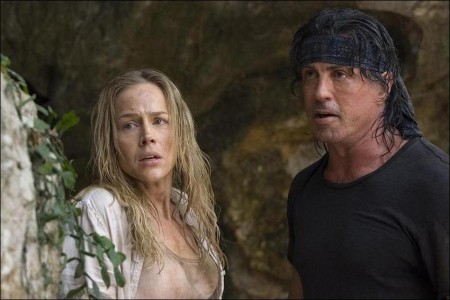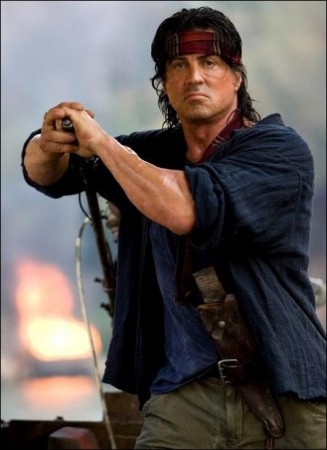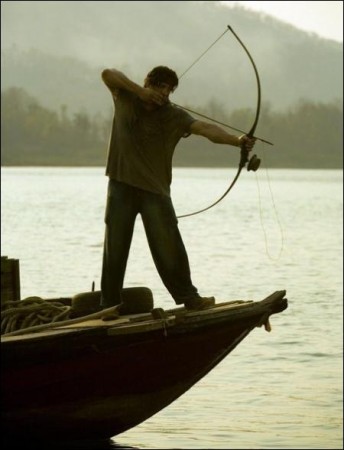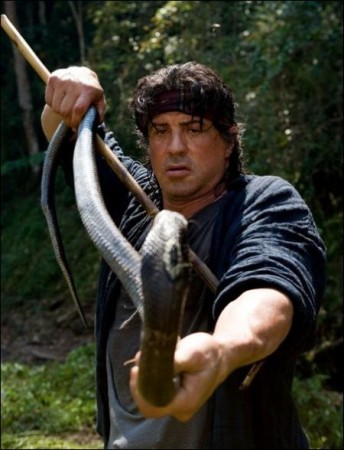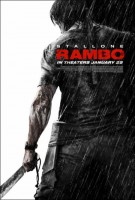Twenty years after the last film in the series, John Rambo (Sylvester Stallone) has retreated to northern Thailand, where he’s running a longboat on the Salween River. On the nearby Thai-Burma (Myanmar) border, the world’s longest-running civil war, the Burmese-Karen conflict, rages into its 60th year. But Rambo, who lives a solitary, simple life in the mountains and jungles fishing and catching poisonous snakes to sell, has long given up fighting, even as medics, mercenaries, rebels and peace workers pass by on their way to the war-torn region.
That all changes when a group of human rights missionaries search out the “American river guide” John Rambo. When Sarah (Julie Benz) and Michael Bennett (Paul Schulze) approach him, they explain that since last year’s trek to the refugee camps, the Burmese military has laid landmines along the road, making it too dangerous for overland travel.
They ask Rambo to guide them up the Salween and drop them off, so they can deliver medical supplies and food to the Karen tribe. After initially refusing to cross into Burma, Rambo takes them, dropping off Sarah, Michael and the aid workers…
Less than two weeks later, pastor Arthur Marsh (Ken Howard) finds Rambo and tells him the aid workers did not return and the embassies have not helped locate them. He tells Rambo he’s mortgaged his home and raised money from his congregation to hire mercenaries to get the missionaries, who are being held captive by the Burmese army. Although the United States military trained him to be a lethal super soldier in Vietnam, decades later Rambo’s reluctance for violence and conflict are palpable, his scars faded, yet visible.
About the Production
In October 1982, film audiences around the country cheered as they watched a Vietnam vet named John Rambo single-handedly take down a posse of blood-hungry policemen and National Guardsmen in the Oregon wilderness. A rousing populist fable that reflected the public’s growing discontent with the political establishment, Rambo: First Blood became a world-wide box office hit, spawning two sequels and transforming Sylvester Stallone, fresh off the success of Rocky, into one of the biggest stars of his generation.
Most notable, however, was John Rambo’s ascension to the ranks of global icon, a position which, two-and-a-half decades later, is undiminished. One can still find Rambo mudflaps and shopping bags in the Far East, Rambo T-shirts in Africa and Rambo action figures in Central America. His presence continues in our political discourse as well, whether it’s former soldier Jessica Lynch disavowing the “little girl Rambo” scenario of her Iraqi capture, or the recent 2007 Pentagon report on the military’s mental health programs that was dubbed, “The Rambo Problem.” Now, twenty-five years after Rambo: First Blood”s premiere, Oscar-winner Sylvester Stallone contributes his talents as co-writer, director and star to Rambo, the next chapter in the saga.
Despite nineteen years having transpired since the last Rambo installment, Stallone and producers Avi Lerner, Kevin King-Templeton and John Thompson were confident that audiences would still connect with Rambo’s personal fortitude. “Rambo harkens back to that mythic one man who has been chosen to do a job that he really doesn’t want to do, but he’s been born to do it,” Stallone explains. “He imparts a sense of virtue that’s immediate. Bad and evil should be punished and the weak should be protected. It harkens back to the stories we all grew up with, the mythology of good and evil.”
“Rambo embodies the individual triumphing over enormous odds,” says producer Kevin King-Templeton. “He’s become an internationally recognized character because only one man has played him and only one man can play him. That’s Sylvester Stallone and he brings a consistent ferocity to the character that is undeniable.”
Unlike comic book heroes who are often endowed with fantastical powers, Rambo represents a powerful primitivism that transcends cultural boundaries. He forges his own weapons, overpowers armed men with only a bow and arrow, and uses his combat wits to outsmart his opponents. Most importantly, his intentions are unwaveringly noble. Despite being betrayed by his own countrymen, he never fails to be guided by a higher, moral purpose.
“Rambo is a man who has dropped out of a very complex, civilized modern world to live in a simple, instinctual way,” says producer Avi Lerner. “He speaks to a sense of disenfranchisement and to a very basic sense of rugged individualism.”
“He’s that classical warrior archetype that translates into any language,” adds co-star Graham McTavish, who portrays the mercenary leader, Lewis. “He’s in the tradition of Beowulf, Achilles – people who are bigger than the men around them, who live outside normal society. The great thing about him is that he doesn’t reflect. He acts. He moves forward while other people are standing still and wondering what to do.”
Having purchased the rights to the Rambo sequels from the Weinstein brothers at Miramax, NuImage producer Lerner was the first to approach Stallone about continuing the Rambo story. Stallone volunteered to write the script; however, he was adamant that they should go forward only if they found a compelling story for the next installment. “I thought, `If I do another Rambo film, I want it to be about something,’” explains the actor. “I didn’t want it to be a caper or about drugs or a jewel heist. I wanted it to be about the human condition.”
Several ideas and scripts for a sequel had already been circulating Lerner’s office, all of them set against well-known conflicts such as Iraq, Afghanistan, Sudan, Colombia, even Darfur; but Stallone wanted to find a less obvious backdrop, set in one of the word’s lesser-known areas of conflict. “I started researching and asking around,” he explains. “I called Soldier of Fortune magazine and I called the United Nations. I asked them `What is the most under-reported, most graphic and devastating abuse of human rights on the planet?’ And they said, `Burma.”
Rambo focuses on a particular conflict within Burma between the Karen ethnic tribe – a minority group – and Burma’s ruling military junta, which assumed control of the country after the collapse of British colonialism at the end of WWII. For sixty years, the Karen have been fighting to establish an autonomous state while suffering a brutal genocide at the hands of the Burmese government.
“I thought the Burmese setting would be ideal because it’s a story that’s not just about Rambo. It’s actually happening. It’s true,” says Stallone. “From the time I heard about it and began researching it, I thought, `If I could just combine the two – raising awareness of the Karen-Burmese civil war and giving the audience a good adventure story – that would be perfect.’”
Suppression of the Karen genocide story has succeeded largely because Burma has cut off its diplomatic and media ties to the west. “The Burmese government is extremely, extremely secretive about this conflict,” says King. “Hopefully, there is an awareness that will come out with the film and this is inspiring to everyone who’s worked on it. We hope it will provoke thought and make a difference.”
While each of the previous Rambo films addressed the pressing political issues of its day, Rambo has managed to prefigure recent headlines. Less than five months after production ended, in late September, 2007, Stallone, the filmmakers, and the rest of the world watched dramatic, rare images of massive pro-democracy protests in Burma / Myanmar led by thousands of Buddhist monks in deep red robes. The military junta quelled the demonstrations by beating, arresting and killing protestors, blocking the Internet and controlling telephone communications. Official death tolls are difficult to know, given the secrecy and lack of information available.
Picking up Rambo’s story some 20 years later, Stallone imagined him still psychologically unable to return home, living a solitary, monastic lifestyle in Southeast Asia. “Rambo is like a dropout,” says Stallone. “He’s lost his faith in humanity and is basically living out his life in solitude.”
When a group of Christian missionaries ask Rambo to transport them up the Salween River to a remote Karen village, he refuses. But an idealistic young missionary named Sarah appeals to his long-dormant sense of duty and changes his mind. Weeks after the journey, Rambo learns that the same missionaries are being held captive by the Burmese military, outside diplomatic reach. Accompanied by a group of Church-hired mercenaries, he agrees to go up the river again, feeling a responsibility to rescue the captives.
Stallone researched the story for months, wanting to return to the spirit of Rambo in First Blood – a damaged but dedicated man nearly destroyed by the violence he’s seen. “This is not the body-oiled Rambo of twenty years ago,” says co-star Julie Benz, who portrays Sarah. “This is Rambo decades later, worn down by life, much more sympathetic. You see how everything he has gone through and experienced – in Rambo I, II and III – has affected his life.”
“If you look at First Blood, there was a reason behind the violence, and Rambo really had a soul,” says actor Tim Kang, who plays the mercenary En-Joo. “I think with this film that kind of depth has come back full force.
Rey Gallegos, who plays the mercenary Diaz, agrees. “In a nutshell, the film is about John Rambo finding himself. The incidents in this movie bring him back again to the man he was. He finds his way home again.”
Stallone says he never intended to write and direct Rambo, but after his positive experience writing and directing Rocky Balboa, he realized he enjoyed the creative control. “When someone else does it, you have regrets and it doesn’t have your personality,” he admits. “This way it’s a direct through-line and very pure. If something does go wrong, I will have no regrets. I’ll say, `Well, I did the best I can. It’s no one else’s fault but mine.’”
Stallone’s first challenge as a director was finding the appropriate cast, and he found a particularly effective co-star in Julie Benz (Punisher: War Zone, Showtime’s “Dexter”), who brings a convincing depth and tenacity to the character of Sarah. “Sarah is a Christian missionary and it’s her first time on this mission with her fiancé, Michael,” says Benz of her character. “She’s a person who is led by her faith.”
“I think Sarah stirs something in Rambo, his innate sense of good versus evil,” explains Stallone. “He sees this beautiful young woman, and her doctor boyfriend, who are willing to risk their safe and comfortable lives to help people they don’t even know who live on the other side of the world. That awakens something in him. By saving Sarah, and trying to save the missionaries, he’s also saving part of himself.”
Benz, who had never worked on an action film before, hired a trainer as soon as she got the role. “I started training twice a day, six days a week because I knew as the only woman in the film I was going to have to hold my own against all these very, very tough men, including Sylvester Stallone,” she says.
Stallone also researched the mercenary industry in detail and created authentic roles for the group of hired soldiers that accompanies Rambo upriver. British-born actor Graham McTavish portrays the group’s leader, Lewis, a violent, money-driven man who experiences an unexpected redemption in the course of battle. Jake La Botz’s Reese is a former soldier who’s unfazed by the violence he witnesses; Diaz, played by Rey Gallegos, is a lapsed idealist who has become a mercenary to support his family; and School Boy, played by British actor Matthew Marsden, is the youngest and least jaded, a young man who still believes in the moral worth of the mission. “He’s the most naive mercenary of the group,” explains Marsden. “He still has this noble ideal of what he’s doing, whereas the rest of them are in it for the money.”
Apart from the Western roles, Stallone’s script called for a vast array of Thai/Burmese actors. Stallone urged Thai casting director Pasiri ‘Noiy’ Pana to avoid professional actors and cast native Karen / Burmese who were from the region and knew about the conflict. While locating real Karen refugees, amputees, land mine victims and former Burmese soldiers, Pana was amazed by how many people knew of John Rambo. “I asked them, `Do you know Rambo?’ and the answer was always, `Yes. Yes,’” she says. “They said that in their villages and homes many of them had watched the films in secret.”
The production even cast a former resistance fighter for the Karen rebels in one of the lead roles. Muang Muang Khin, who plays the vicious Burmese Major Tint, joined the Karen rebels after the September 1988 uprising in Rangoon and fought on the front lines against the Burmese for years. While he had no acting experience, he impressed Stallone with his real-life experience and passion for the subject. Khin took the role despite the threat of Burmese reprisals for appearing in the film. “After this film is released, I shall keep a low-profile because Burmese intelligence is everywhere, even in Thailand, and there could be some retaliation,” explains Khin. “But I had to take the part. I want the world to know what is actually going on here.”
The producers and Stallone worked closely with Pana to ensure the anonymity of many of the Thai and Burmese actors and extras working in the film. “We were concerned and explained the situation to them,” Pana says. “But they all knew Rambo and wanted to be part of it. And Sly assured them that someone was going to tell their story.”
Determined to be as authentic as possible, Stallone based the production in the northern Thai capital of Chiang Mai, an ancient city that was the closest possible base to the war-torn Thailand-Burma border. Logistically, Rambo was a huge, complex production, with nearly 500 crewmembers communicating in five different languages. “We had a crew comprised of thirteen different nationalities,” reports Thompson. “We had actors from seven different countries. Every day, we had more than sixty stuntmen and hundreds of extras. We even constructed a village and a small city.”
In addition to creating a mobile production consisting of over 200 vehicles, the filmmakers also built six vessels, including replicas of a Burmese navy patrol boat, the Burmese pirate boat and Rambo’s longboat. For the film’s Burmese army compound, production designer Franco-Giacomo Carbone led his production team to clear more than four acres of jungle and construct over 50 buildings. The nearby Karen village set required leveling hillsides, creating irrigation and rice paddy terraces, building 34 bamboo structures, and bringing in plants, livestock and other animals.
Stallone shot daily with as many as five cameras at once, working with director of photography Glen MacPherson, CSC, ASC and camera operator Vern Nobles to find innovative ways to capture all of the action at once. The goal of using the camera to accentuate the terrifying and confusing moments of conflict meant running Steadicam and racing ATV-shots through the jungle and rigging cameras to leap off cliffs or fly above the wide-spread action.
Without any indoor or stage locations, the filmmakers worked for three months in rain, hail, thunder, lightning, flooding and high altitudes and spent weeks shooting at night in the jungle under rain machines. Daytime temperatures in the mountain jungles soared into the 100s every day. The mid-February start date also fell in the middle of Thailand’s “burning season,” the period of drought and field clearing from January to April. At some locations, fistfuls of ash and palm-size cinders rained down and covered the scorched jungle floor. The hours spent in the jungle also exposed the cast and crew to a wide variety of native insects, including spiders, scorpions, ants, mosquitoes, fleas and numerous poisonous snakes: cobras, green snakes, tree snakes, and vipers. “There were ants that you could put saddles on and ride home,” says McTavish. “And snakes were everywhere. I saw four in one day on second unit, one of which was crawling up one of the actor’s legs.”
“It was a gloriously brutal experience,” says Stallone. “The cast and crew worked under unbelievable hardship. In this day and age, when the film world has become mechanized and computerized, this was truly the last of old-school filmmaking. It’s harder than anything I’ve ever done before, but also more rewarding.”
“I thought I was prepared, but I was tested beyond what I thought I would experience,” confesses Marsden.
While most of the cast echoes this sentiment, they were uniformly inspired by Stallone’s unflagging energy and commitment to the production. “Sly works from the moment he gets up until the moment he goes to bed,” reports McTavish. “When you have a director with that kind of focus and intensity at the top, it filters down, and everyone else follows it.
Remembers Benz, “You would watch Sly on the set and he’d be in there, literally shoveling pig shit, chopping down trees and then turning around and delivering this amazing, fully intense performance, then going back to figure out the camera work for the next shot, He inspired everyone around him. He’s very smart, really funny and has amazing charisma. He was tough as a director, brutally sometimes, but he pushed us all to go the extra mile and do things we didn’t think we could do.”
Adds La Botz, “Sly has true artistic vision. He would come on set and wasn’t afraid to make people crazy by changing things. The result was a collaborative process – and a film – that’s raw and alive.”
Thompson, who has been producing films for more than 30 years, found Stallone to be a consummate director. “Sly’s one of the best directors I’ve ever worked with – and I’ve worked with lots of them,” he avows. “The powerful and economic way in which he creates the visual narrative is especially impressive to me.”
King, who has known Stallone for years, sees the making of Rambo as yet another formidable challenge in a career defined by them. “Sly is a risk-taker and he always has been,” says King. “The first Rocky was a risk for him. So was the first Rambo film. And now, to revive a character after twenty years, to be on screen at age 60 as an action hero, to get into that physical condition, to direct and handle this huge production, to deal with the dangerous and horrific issues in Burma, they’re all risks. His career is full of taking risks and that’s what makes him such an icon. He’s not afraid.”
Stallone simply hopes he can continue making films, especially now that he has the advantage of age and experience. “I feel like I have more experience, more knowledge, and more to offer,” says the actor, writer, director and producer. “I have a lot left to say.”
Production notes provided by Lionsgate Films.
Rambo
Starring: Sylvester Stallone, Julie Benz, Paul Schulze, Matthew Marsden, Graham McTavish, Rey Gallegos, Tim Kang, Jake LaBotz, Maung Maung Khin, Ken Howard
Directed by: Sylvester Stallone
Screenplay by: Art Monterastelli, Sylvester Stallone, Jeb Stuart
Release Date: January 25, 2008
MPAA Rating: R for strong graphic bloody violence, sexual assaults, grisly images.
Studio: Lionsgate Films
Box Office Totals
Domestic: $42,754,105 (37.8%)
Foreign: $70,489,881 (62.2%)
Total: $113,243,986 (Worldwide)
